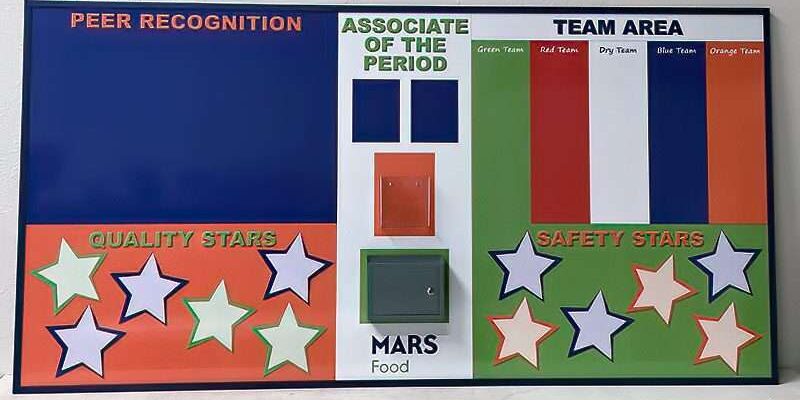In the fast-paced world of manufacturing and project management, efficiency and productivity are paramount. One of the key tools that organizations are increasingly turning to is the production board. These visual management tools provide a real-time snapshot of workflows, tasks, and progress, fostering collaboration and transparency within teams. In this article, we will explore the concept of production boards and delve into some innovative solutions that inspire productivity in various industries.
Understanding Production Boards
Production boards, also known as task boards or Kanban boards, are visual displays that depict the flow of work within a team or organization. Originating from the lean manufacturing principles of the Toyota Production System, these boards have evolved to become a versatile tool applicable to a wide range of sectors. The primary goal is to provide a clear and accessible overview of work items, enabling teams to manage their tasks efficiently and optimize their workflows.
Key Components of a Production Board:
- Task Columns: These represent the different stages of a project or manufacturing process. Typically, tasks move from left to right as they progress.
- Task Cards: Each task is represented by a card containing essential information such as task description, assigned team member, and due date.
- Visual Indicators: Color-coded labels, priority markers, or status flags provide at-a-glance information about the current state of each task.
Inspiring Production Board Solutions
- Digital Kanban Boards: Embracing technology, digital Kanban boards bring the benefits of production boards to the digital realm. Platforms like Trello, Asana, and Jira offer customizable digital boards that can be accessed from anywhere, fostering remote collaboration and real-time updates.
- Integration with Project Management Software: To enhance efficiency, some production boards seamlessly integrate with project management tools. This allows teams to link tasks to broader project goals, allocate resources effectively, and monitor progress without the need for manual updates.
- Customizable Templates: Recognizing that different industries have unique workflows, modern production board solutions offer customizable templates. This flexibility allows organizations to tailor their boards to specific processes, ensuring a better fit for their operational needs.
- Automation and Artificial Intelligence: Cutting-edge production board solutions leverage automation and AI to streamline processes further. Automated task assignment, predictive analytics for resource allocation, and intelligent scheduling contribute to a more efficient and proactive workflow.
- Mobile Accessibility: In a world where work is increasingly conducted on the go, production board solutions that offer mobile accessibility are crucial. Team members can view and update tasks, communicate with colleagues, and monitor progress from their smartphones, promoting flexibility and responsiveness.
Collaboration in the Digital Age: The Rise of Virtual Production Boards
As remote work becomes increasingly prevalent, the need for virtual collaboration tools has never been greater. Discover how digital production boards are evolving to meet the demands of distributed teams, offering features that promote seamless communication, real-time updates, and the ability to adapt to the challenges of a dynamic work environment.
Beyond Traditional Kanban: Agile Production Board Strategies
While traditional Kanban boards have proven effective, some industries require a more dynamic and adaptive approach. Explore how agile production board strategies are pushing the boundaries, incorporating iterative development cycles, feedback loops, and continuous improvement principles to drive efficiency and innovation in modern workplaces.
Case Studies: Real-world Success Stories with Production Boards
Learn from the experiences of organizations that have successfully implemented production boards to revolutionize their workflows. These case studies highlight diverse industry applications, showcasing the tangible benefits achieved, challenges overcome, and the valuable lessons learned during the adoption of production board solutions.
Sustainability in Focus: Eco-Friendly Production Board Practices
In an era where sustainability is a global priority, this section explores how production boards can contribute to eco-friendly practices within organizations. From reducing paper usage to optimizing energy consumption through digital solutions, discover how businesses can align their productivity goals with environmental responsibility.
The Human Factor: Cultivating a Productivity Mindset with Production Boards
Beyond technology and processes, the human element plays a crucial role in the success of production boards. Explore strategies for fostering a productivity mindset within teams, including training programs, motivational techniques, and leadership practices that empower individuals to fully harness the potential of production board solutions.
Benefits of Inspiring Production Board Solutions:
- Enhanced Collaboration: Production boards facilitate open communication and collaboration among team members, breaking down silos and ensuring everyone is on the same page.
- Increased Transparency: With real-time updates and visual indicators, production boards provide a transparent view of work progress, enabling better decision-making and resource allocation.
- Efficient Resource Management: Intelligent production board solutions help organizations allocate resources effectively, preventing bottlenecks and optimizing overall productivity.
- Adaptability to Change: Customizable templates and agile features allow teams to adapt quickly to changing priorities, ensuring that the production board remains a relevant and powerful tool over time.
Conclusion
In the quest for enhanced productivity, organizations are turning to innovative production board solutions. Whether in the form of digital Kanban boards, AI-powered automation, or mobile-friendly interfaces, these tools are transforming the way teams collaborate and manage their work. By embracing such solutions, businesses can streamline their processes, boost efficiency, and ultimately achieve their production goals with greater success.












